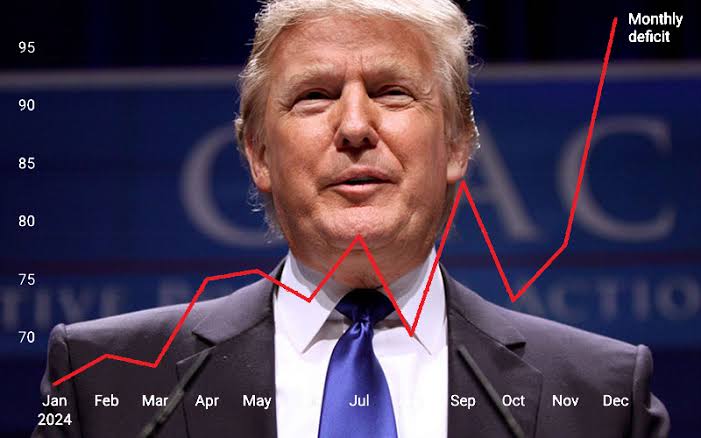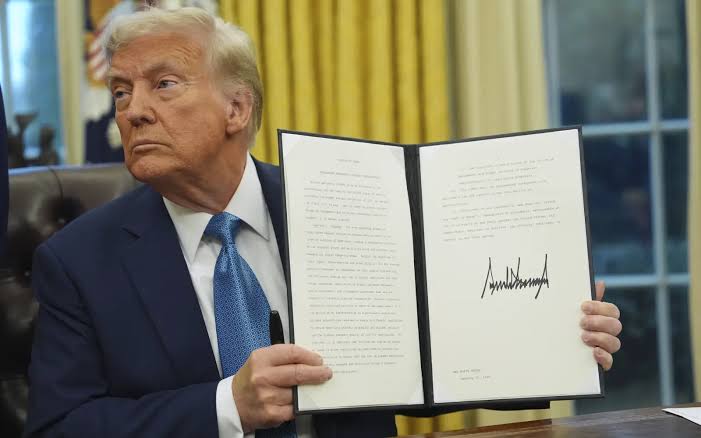Late Wednesday afternoon, a palpable tension swept through the financial markets as U.S. stock futures plunged following President Trump’s surprise announcement of new reciprocal tariffs at a “Liberation Day” event hosted at the White House. This unexpected move sent shockwaves through the investment community, rattling indexes and leaving traders scrambling to reassess their positions amid rising fears of a potential trade war.
A Market Under Pressure
Around 4:45 p.m. ET, the futures on the S&P 500 dropped by 1.7%, the Nasdaq 100 futures sank by 2.5%, and the Dow Jones Industrial Average futures fell by 0.7%. Just hours earlier, earlier trading had provided a fleeting glimpse of recovery—major indexes had managed to shake off early losses. The S&P 500 had been up by 0.7%, the Dow had climbed nearly 0.6% (gaining over 200 points), and the Nasdaq Composite had risen about 0.9%. Yet, as the clock ticked closer to the tariff announcement, market sentiment shifted dramatically.
The catalyst was President Trump’s tariff declaration, a strategic move intended to address perceived imbalances in trade with various U.S. trading partners. The tariffs, branded as part of a “Liberation Day” celebration, aimed to force reciprocal measures from those nations. However, this decision came without much warning, leaving investors with little time to digest the potential ramifications for the U.S. economy.
The Unexpected Announcement
In a moment that caught even seasoned analysts off guard, Trump unveiled the new tariffs during a high-profile event at the White House. This move, intended to assert American strength and recalibrate trade deals, has instead raised alarm bells among economists and market watchers. The sudden imposition of these duties is expected to disrupt global supply chains, alter trade flows, and add a fresh layer of uncertainty to an already volatile economic landscape.
The announcement rattled the stock market, sending shockwaves across various sectors. Investors immediately began re-evaluating the risks associated with their portfolios. With key economic indicators such as the 10-year Treasury yield inching up by about 4 basis points to 4.19%, signaling a slight shift in investor sentiment towards safer assets, it’s clear that the impact of these tariffs may extend far beyond short-term market fluctuations.
A Day of Contrasts: Early Gains and Sudden Losses
Before the dramatic turn of events, the trading day had seen notable gains, particularly from stocks like Tesla and Amazon. Tesla shares had experienced a volatile ride—initially falling nearly 5% after weaker-than-expected first-quarter deliveries. However, after a Politico report hinted at potential changes in Elon Musk’s government role, the stock rebounded by more than 5%. Similarly, Amazon shares surged by about 2% following a New York Times report suggesting the tech giant was making a last-minute bid for TikTok. These individual stock movements contributed to an optimistic start to the day.

Yet, this early enthusiasm was quickly overshadowed by the shock of Trump’s tariff revelation. The initial recovery seen in major indexes was abruptly wiped out as the new trade policy sent investors into a defensive mode. The unexpected nature of the announcement not only undermined confidence but also reintroduced fears that long-standing trade policy uncertainty would continue to disrupt market stability.
Unpacking the Tariff Shock
The new tariffs are expected to impose duties on a range of imported goods from key trading partners, and while specifics are still emerging, the potential consequences are significant. Analysts warn that these tariffs could ignite a full-scale trade war, as countries retaliate by imposing their own restrictions on U.S. goods. Such tit-for-tat measures have the potential to escalate rapidly, leading to decreased international trade, higher consumer prices, and a dampening of economic growth.
This policy move, which seems designed to force a renegotiation of trade terms, may come at a cost. The immediate market reaction—a swift drop in stock futures—is just one indicator of the broader economic anxiety. Businesses that rely on global supply chains, export-driven sectors, and multinational corporations are likely to feel the impact most acutely. Meanwhile, sectors such as technology, manufacturing, and retail may face heightened uncertainty as the cost of imported raw materials and components increases.
Investor Sentiment and Market Volatility
In times of economic uncertainty, investor sentiment becomes a critical driver of market behavior. The sudden tariff announcement has generated a wave of pessimism among traders, as evidenced by the sharp decline in key market indexes. The futures market, a bellwether for overnight trading activity, reacted swiftly, indicating that market participants are bracing for potentially turbulent times ahead.
Keywords like “stock market today,” “futures sink,” “tariff shock,” “trade war fears,” and “economic uncertainty” are now dominating headlines and social media conversations. Analysts are busy parsing the details of Trump’s speech, trying to discern the long-term implications for U.S. fiscal policy and global trade dynamics. The rhetoric of “reciprocal tariffs” and “trade policy uncertainty” has taken center stage, fueling debates among economists, policymakers, and investors alike.

The Role of Economic Data
Amid the trade policy shakeup, recent economic data has provided a mixed picture of the U.S. economy’s health. ADP data revealed that the private sector added more jobs in March than expected, a sign that the labor market remains resilient despite external shocks. This optimistic employment data set the stage for the upcoming March jobs report, which will be closely scrutinized by market watchers seeking insights into the broader economic impact of the tariffs.
At the same time, the upward tick in Treasury yields indicates that investors are shifting their focus to traditionally safer investments in light of heightened market risk. As bond prices adjust and yields rise, the cost of borrowing could increase, potentially slowing down business investments and consumer spending. This interplay between fiscal data and market reaction underscores the complex dynamics at play in today’s trading environment.
Navigating Through the Trade War Debate
The looming possibility of a trade war has long been a topic of heated discussion among economic experts and political commentators. The imposition of tariffs is one tool that governments use to protect domestic industries, but it also carries the risk of retaliation. In this instance, Trump’s “Liberation Day” tariffs have added another layer of complexity to an already fragile global trade framework.
Critics argue that these tariffs could harm the U.S. economy by disrupting supply chains and increasing costs for both businesses and consumers. On the other hand, supporters claim that such measures are necessary to level the playing field and compel trading partners to negotiate better terms. This debate—centered on keywords like “trade policy,” “tariff impact,” “global trade,” “economic protectionism,” and “reciprocal duties”—is likely to intensify in the coming weeks as more details about the tariffs emerge.
Sector-Specific Impacts
Different sectors of the economy are likely to be affected in varied ways by the new trade measures. For instance, the technology sector, which has already seen volatility with companies like Amazon and Tesla experiencing significant stock fluctuations, may face further uncertainty. High-tech manufacturing, reliant on imported components, could see increased production costs that might ultimately be passed on to consumers.
The retail industry, too, is not immune. With tariffs potentially driving up the prices of imported goods, retailers may face squeezed margins or have to adjust their pricing strategies to maintain profitability. Meanwhile, industries such as agriculture and energy, which often find themselves at the mercy of international trade agreements, may need to navigate a rapidly shifting policy landscape that affects both exports and imports.

The Broader Economic Picture
Beyond the immediate shock to stock futures, Trump’s tariff announcement represents a broader challenge to the global economic order. As one of the world’s largest economies, the U.S. wields significant influence over international trade norms. When its policies shift abruptly, the ripple effects can be felt far and wide—from currency markets to commodity prices, from industrial production to consumer sentiment.
The fear of a potential trade war looms large in this context. If other countries respond with their own tariffs, the resulting escalation could lead to a significant contraction in global trade. Such a scenario would likely result in slower economic growth, reduced investment, and increased uncertainty in financial markets. In essence, the announcement has not only shaken stock market futures but has also underscored the interconnectedness of today’s global economy.
A Moment of Reckoning for Market Participants
For investors, the sudden decline in stock futures is a stark reminder of the risks inherent in a globally connected market. While some may view this as an opportunity to buy on the dip, others may choose to adopt a more cautious stance, reallocating their assets to mitigate risk. The keywords “market volatility,” “investment risk,” “portfolio diversification,” “economic uncertainty,” and “fiscal policy” now resonate more strongly as market participants reassess their strategies.
Many are closely monitoring the situation, using technical and fundamental analysis to gauge whether this tariff-induced shock is a short-lived setback or a harbinger of more prolonged instability. The balancing act between seeking potential gains in a volatile market and protecting capital in uncertain times is a challenge that every investor must confront in today’s trading environment.
Looking Ahead: The Path to Stability
As the trading day winds down, market analysts are left to ponder the long-term implications of Trump’s tariff announcement. While the immediate reaction has been one of caution and retreat, some experts believe that the markets may eventually stabilize as investors digest the news and adjust their expectations. The resolution of trade disputes, or at least a clearer understanding of what the new reciprocal tariffs will entail, could restore some degree of confidence in the financial system.
The upcoming release of the March jobs report, combined with other economic indicators, will provide further insight into whether the U.S. economy can weather this latest bout of uncertainty. In the meantime, investors and policymakers alike will be keeping a close eye on how these developments play out, both in the stock market and across the broader economic landscape.
A Snapshot of Today’s Market Keywords
In the midst of this unfolding story, certain keywords have become synonymous with the day’s events:
- Stock futures today
- Tariff shock
- Liberation Day tariffs
- Reciprocal tariffs
- Market volatility
- Trade war fears
- Economic uncertainty
- S&P 500 decline
- Nasdaq drop
- Dow Jones futures
- Tesla rebound
- Amazon stock surge
- 10-year Treasury yield
- ADP jobs data
- Global trade impact
- Investor sentiment
- Policy uncertainty
These phrases encapsulate the many dimensions of the current market turmoil, serving as a focal point for discussions in boardrooms, trading floors, and online financial forums alike.
In Conclusion: A Day of Uncertainty and Opportunity
Today’s market movements, driven by the shock of newly imposed tariffs, illustrate the intricate dance between policy decisions and economic realities. President Trump’s announcement at the White House has created a ripple effect that extends from Wall Street to global trade circuits. The fall in stock futures—across major indexes like the S&P 500, Nasdaq 100, and Dow Jones—reflects not only immediate investor reactions but also a broader apprehension about the future direction of U.S. trade policy.
For those navigating the complexities of the modern financial landscape, today serves as both a cautionary tale and a call to stay vigilant. As debates over tariffs, trade policy, and economic stability continue to evolve, the markets remind us that every announcement, every policy shift, carries the potential to reshape our financial futures. Investors, economists, and policymakers now face the challenge of adapting to a world where uncertainty is the only constant—and where the interplay between politics and the economy is more critical than ever.
In the end, the story of today’s stock market is one of rapid change, dynamic market sentiment, and the relentless search for stability amid chaos. As traders monitor every tick of the index and analysts dissect every headline, one thing is clear: in the high-stakes arena of global finance, staying informed and agile is not just a strategy—it’s a necessity.
While the market awaits further clarity on the scope and impact of the new tariffs, investors are left to weigh the risks and opportunities that come with a shifting economic landscape. The road ahead is uncertain, but for many, this period of adjustment may also be a time to re-evaluate investment strategies, diversify portfolios, and prepare for a future where every decision counts.
Ultimately, today’s events underscore a timeless truth in the world of finance: the forces of policy and economics are in constant flux, and the ability to navigate these changes is what defines successful investing. Whether you’re a seasoned trader or a newcomer to the market, the lessons of this tumultuous day will likely inform your decisions for years to come, reminding us all that in the realm of stocks, futures, and global trade, adaptation is key.
As the sun sets on this dramatic day, the echoes of President Trump’s “Liberation Day” tariffs continue to reverberate through the corridors of power and the hearts of investors. In this evolving story, every keyword—from “market shock” to “trade uncertainty”—paints a picture of a financial world that is both unpredictable and full of potential. And as the markets gradually seek a new equilibrium, one thing remains certain: the path to stability will be paved with careful analysis, informed decisions, and the unwavering resolve to embrace change.





One thought on “Today’s stock market sees futures dropping sharply after Trump’s “Liberation Day” tariffs send shockwaves through the markets”